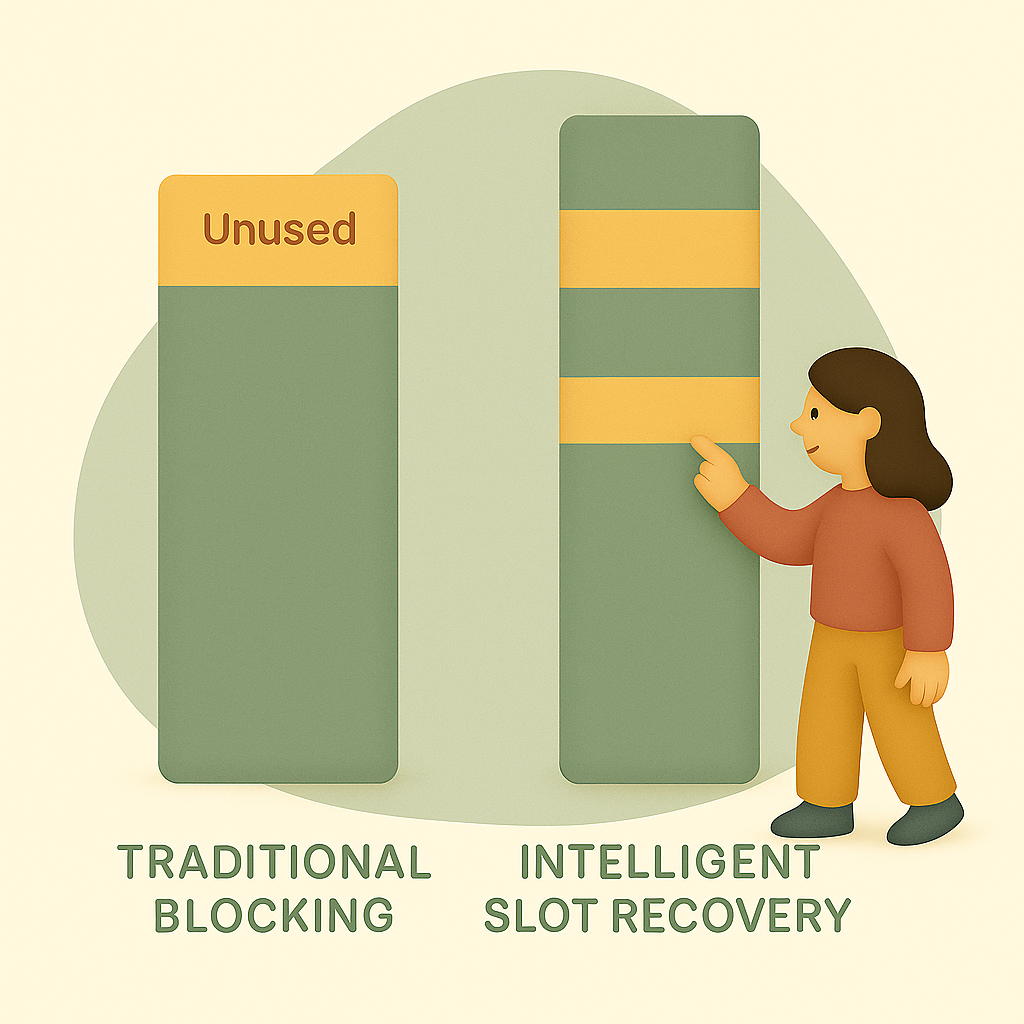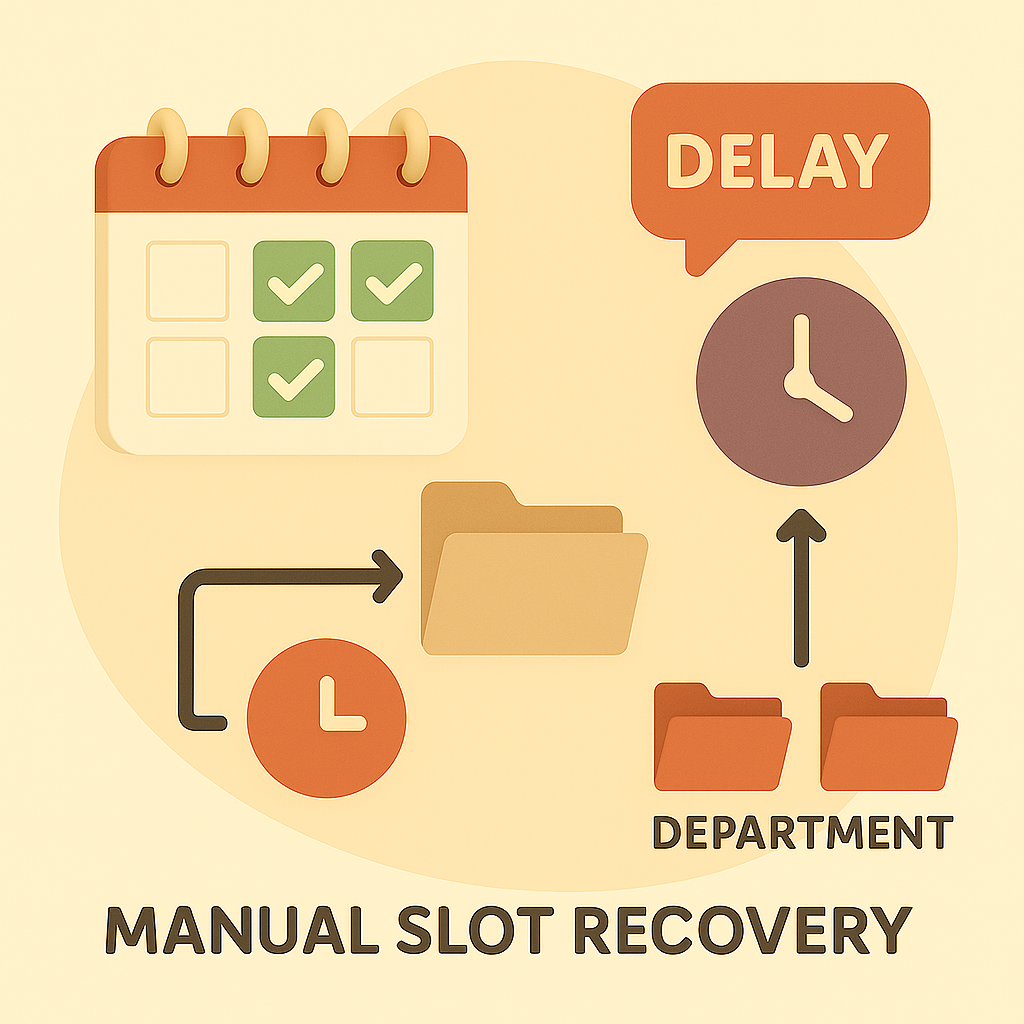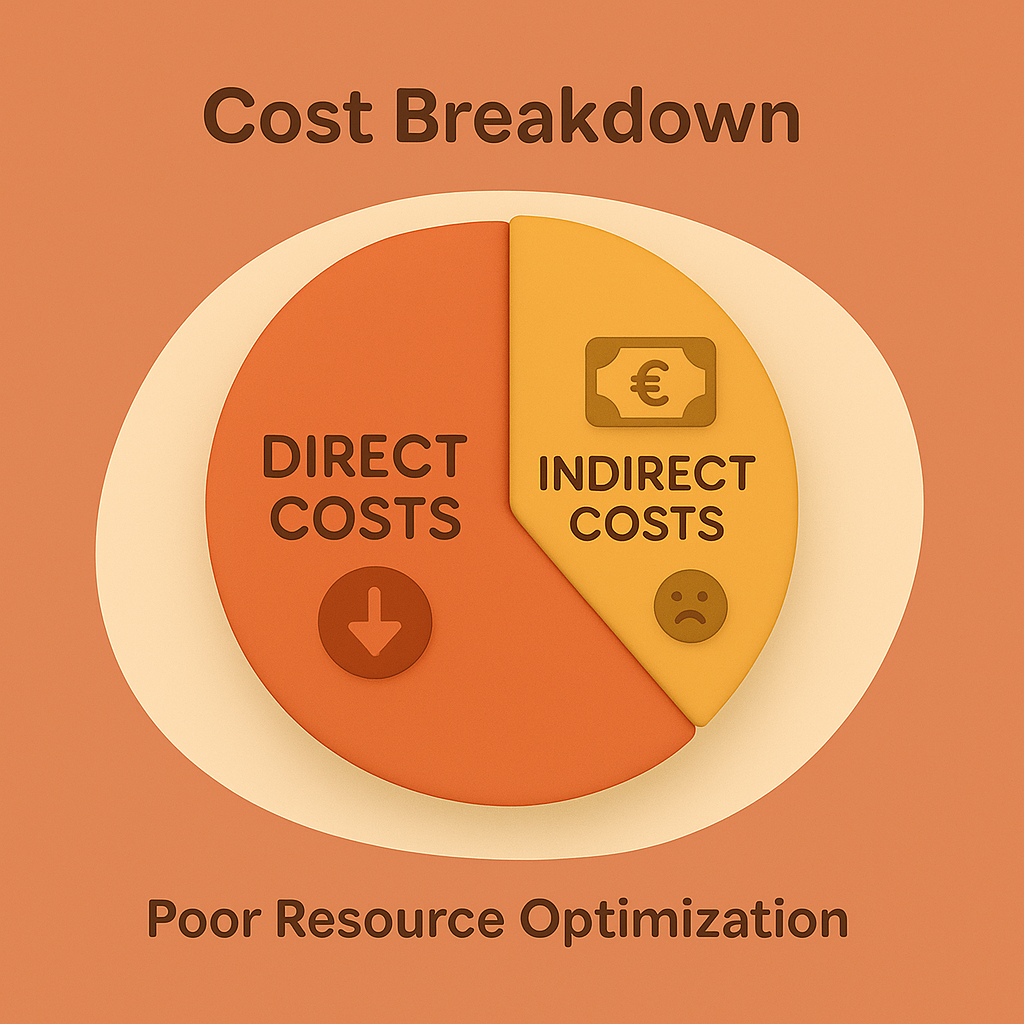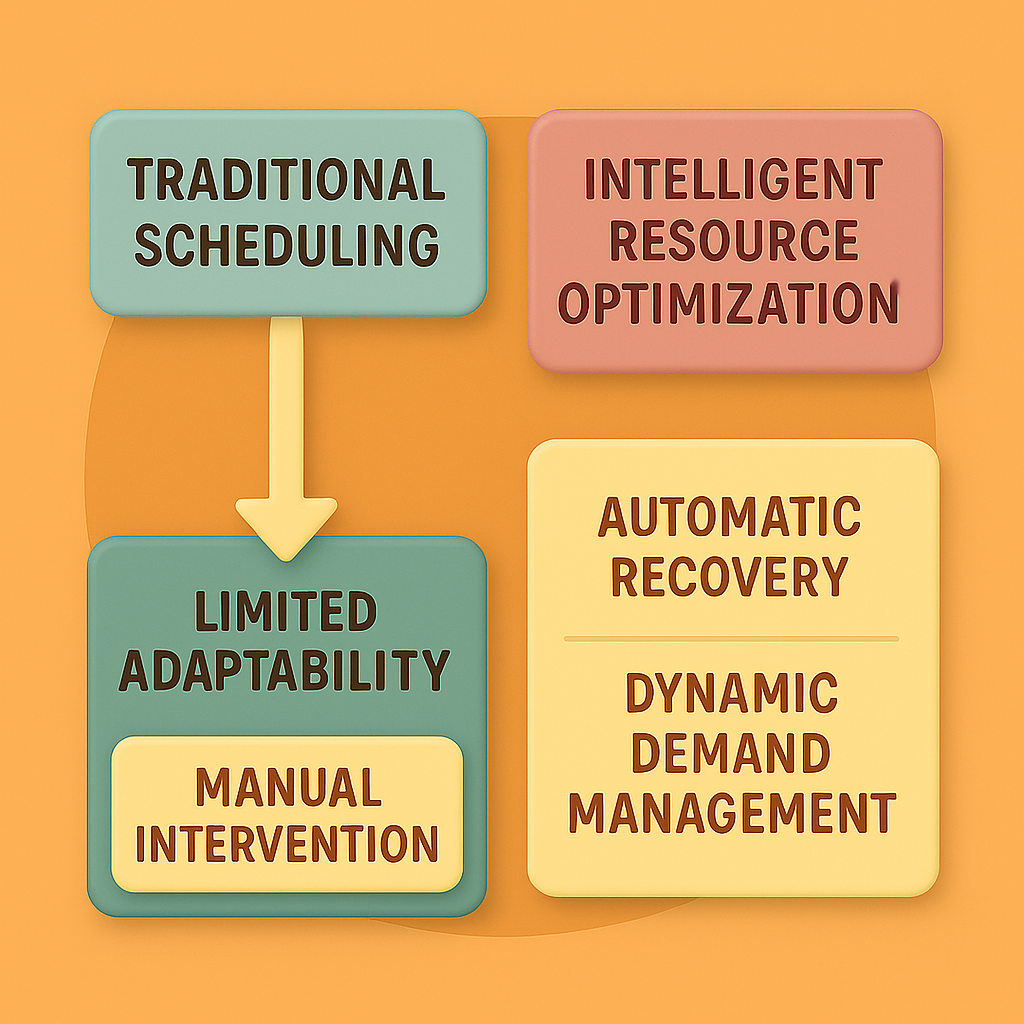Exclusive Access Scheduling: How to Guarantee Client Availability Without Wasting Resources
This article explores the critical balance between guaranteeing client access to consultant time and preventing revenue loss from unused blocked slots, introducing how Smart Links technology solves this resource optimisation challenge.

Introduction to Exclusive Access Scheduling

You’ve secured a valuable corporate client requiring on-site consultations, but there’s a catch: their employees need guaranteed access to your consultant during specific time periods, yet you can’t afford to block hours that might go unused. It’s the classic professional services dilemma—how do you guarantee client availability without sacrificing revenue when demand falls short of reserved capacity? This level of high availability demands significant energy from consultants, and long working hours can negatively impact their well-being and productivity.
This challenge affects thousands of service providers daily. No matter the industry or size of the business, these issues persist. Recent research reveals that traditional appointment coordination costs between €50-500 per appointment, whilst hybrid service models generate up to 50% more revenue than single-channel approaches, but only when resource utilisation remains optimised. The problem is that most scheduling systems force providers into an impossible choice: either guarantee client access and risk revenue loss, or maintain flexibility and disappoint clients with unavailable consultants.
As 67% of customers demand faster response times and 58% seek guaranteed service availability, professional services organisations must solve this resource optimisation puzzle. The expected standard in the industry is for consultants to be highly available and responsive. The financial stakes are substantial—coordination failures cost organisations 15-25% of potential revenue, with much of this loss stemming from inefficient time blocking and poor slot recovery.
Revolutionary scheduling technology now offers a solution that eliminates this trade-off entirely, enabling guaranteed client access whilst maintaining optimal resource utilization through intelligent slot management. The benefit of these solutions is improved efficiency and satisfaction for both providers and clients.
Traditional scheduling systems often fail to manage resources in a methodical manner, leading to inefficiencies and lost opportunities.
The Resource Optimisation Dilemma: When Guarantees Become Costly

Professional services face an increasingly complex balancing act between client satisfaction and revenue optimisation. Clients demand guaranteed access to consultant time, particularly for high-value engagements requiring on-site presence. Yet blocking consultant hours for potential client bookings often results in unused capacity and lost revenue opportunities, while al...so impacting consultant workload and potentially affecting the quality of service delivered.
The challenge intensifies in today’s competitive marketplace, where service differentiation increasingly depends on availability guarantees. Clients expect consultants to be available when needed, not just when convenient for the service provider, and often expect a specific number of hours of consultant availability each week. Meanwhile, providers cannot afford to maintain idle capacity, particularly when 78% of high-performing enterprises are integrating AI into service operations.
This creates a fundamental tension: how do you provide exclusive client access whilst maintaining the flexibility to reallocate unused time slots to other revenue-generating activities?
Common Resource Utilisation Challenges
The resource optimisation crisis affects service providers across multiple industries, with certain challenges appearing consistently regardless of sector size or specialisation.
Challenge 1: Revenue Loss from Unused Blocked Time
Service providers routinely block consultant calendars for client visits, creating exclusive availability windows that often remain partially or completely unused. Unbooked tasks and incomplete bookings during these windows can slow overall progress and negatively impact the project budget, as resources are not fully utilised. When an insurance company reserves three days for on-site employee consultations but only half the slots get booked, tracking completed bookings and the specific dates reserved becomes essential for understanding resource utilisation and financial efficiency. Those unused hours represent direct revenue loss. Traditional scheduling systems provide no mechanism for recovering these blocked slots, forcing providers to choose between client guarantees and revenue optimisation. The financial impact compounds across multiple client accounts and consultant schedules, with appointment coordination costs ranging from €50-500 per appointment, further affecting the overall project budget.

Challenge 2: Inability to Predict and Optimise Demand
Professional services struggle to accurately predict client booking patterns for reserved time periods, leading to either over-allocation that wastes resources or under-allocation that disappoints clients. A physiotherapy centre offering mobile massage services might reserve five therapist days for a corporate wellness programme, only to discover actual demand requires just three days. Gaining an overview of resource usage and tracking the percentage of booked slots can help optimise allocation and improve efficiency. Without dynamic optimisation capabilities, providers cannot adjust resource allocation based on real-time booking patterns. Monitoring the percentage of resource usage is crucial to identify inefficiencies and improve demand prediction. This prediction gap results in systematic inefficiencies across service delivery, contributing to the 74% of mobile workers who report increased customer expectations.

Challenge 3: Manual Slot Recovery and Reallocation
When reserved time slots remain unbooked, service providers must manually identify unused capacity and reallocate it to other clients or activities. Dealing with the complexity of these manual processes requires checking multiple calendars, coordinating with different departments, and managing complex communication chains to release blocked time. Insurance consultants might have unused slots from one client account that could serve another client’s urgent needs, but manual coordination delays prevent executing timely reallocation of jobs to other clients. The administrative overhead involved in reallocating jobs often makes slot recovery impractical, leading to permanent revenue loss that contributes to the 15–25% revenue reduction from coordination failures.

Challenge 4: Client Expectations vs. Resource Flexibility
Clients increasingly demand guaranteed availability whilst expecting providers to maintain competitive pricing that reflects efficient resource utilisation. This creates pressure to provide exclusive access whilst avoiding the premium pricing that blocked time traditionally requires. When client demand exceeds initial resource allocation, clients may request additional resources to ensure their needs are met and the resource plan remains realistic. Professional services must balance client exclusivity with operational efficiency, often compromising one for the other. The inability to offer both guaranteed access and competitive pricing limits business development opportunities and client satisfaction, particularly as 58% of customers want increased remote service options alongside guaranteed availability.

These resource optimisation challenges affect service providers across industries—from financial advisory firms managing client visit schedules to healthcare providers coordinating mobile services. However, the fundamental problem remains consistent: traditional scheduling approaches cannot deliver on client expectations whilst maintaining optimal resource utilisation.
Struggling to Optimise Resources?
Discover how leading service providers solve the availability guarantee challenge whilst maintaining revenue optimisation.
The Hidden Cost of Inefficient Resource Blocking

The financial impact of poor resource optimisation extends far beyond immediately visible revenue loss from unused time slots. Research indicates that inefficient time blocking and slot management create cascading costs across multiple operational areas.
Direct costs include the lost billable hours when blocked time remains unused—with appointment coordination ranging from €50-500 per appointment depending on consultant seniority and service type. In some cases, consultants may not be paid for unused blocked time, leading to dissatisfaction and potential issues with fair compensation. However, indirect costs prove more damaging: client relationships strained by limited availability, competitive disadvantages when unable to offer guaranteed access, and consultant productivity reduced by inefficient scheduling patterns.
Manual processes for managing schedules and appointments are often time-consuming, requiring extensive effort and causing delays. These inefficiencies hinder progress by making it harder to track project milestones and optimise resource allocation.
Professional services operating with fragmented scheduling systems experience significant operational penalties compared to those using hybrid service models, which generate up to 50% more revenue than traditional single-channel approaches. When providers cannot offer guaranteed availability, sales cycles extend and conversion rates decline. Conversely, when providers over-block time to ensure availability, profit margins erode and pricing competitiveness suffers.
The competitive impact compounds over time. As businesses using optimised scheduling technologies achieve superior results, organisations that cannot balance client guarantees with resource optimisation fall increasingly behind competitors who master this balance, ultimately struggling with delivering projects on time and within budget.
Why Traditional Scheduling Cannot Solve Resource Optimisation

Traditional scheduling systems were designed for simple appointment booking, not sophisticated resource optimisation across guaranteed client access and dynamic demand management. These systems operate on static allocation principles that cannot adapt to real-time booking patterns or automatically recover unused capacity. Most traditional scheduling tools also lack features for dynamic resource management, limiting their effectiveness in complex environments.
Most current solutions require manual intervention for every aspect of resource optimisation: blocking time, monitoring utilisation, identifying unused slots, and reallocating capacity. This manual approach creates delays that prevent timely slot recovery whilst requiring administrative overhead that erodes profit margins. There are few valid methods available for automatic slot recovery, making it difficult to efficiently manage resources without significant manual effort.
Integration attempts between different scheduling systems often fail because they address symptoms rather than the fundamental limitation: the need for intelligent automation that understands both client access requirements and revenue optimisation imperatives. Creating a reliable link between disparate systems is challenging, as API connections between calendar systems and booking platforms cannot provide the sophisticated logic required for automatic slot recovery and dynamic resource allocation. Integrated methods for resource levelling, smoothing, and reverse allocation are rarely implemented, further limiting optimisation.
The market gap is substantial. Whilst basic scheduling tools handle simple appointment booking and enterprise resource planning systems manage high-level capacity planning, no traditional solution seamlessly balances guaranteed client access with intelligent resource optimisation.
Industry Impact: When Resource Optimisation Becomes Competitive Advantage

Resource optimisation challenges affect virtually every service-based industry, but forward-thinking organisations are discovering that mastering this balance creates significant competitive advantages. Consulting agencies, in particular, face unique challenges in time utilisation, billing practices, and ensuring profitability through expert time management. Companies that can offer guaranteed client access whilst maintaining optimal resource utilisation win more business and achieve higher profitability.
The field service management market is forecasted to triple by 2032 with a 14–19% CAGR, driven primarily by demand for sophisticated resource optimisation solutions. Organisations that master intelligent scheduling report substantial improvements in both client satisfaction and operational efficiency, especially when managing multiple projects and coordinating teams working together to balance workloads and track project progress.
The implications extend beyond immediate operational benefits. As client expectations continue rising and service markets become more competitive, the ability to guarantee access whilst optimising resources becomes a fundamental business requirement. Applying resource smoothing techniques and following best practices in resource management helps organisations prevent overallocation, maintain project schedules, and ensure tasks are completed within budget. Professional services using hybrid delivery models consistently outperform single-channel competitors by up to 50%.
Professional services that achieve resource optimisation excellence gain multiple advantages: premium pricing justified by guaranteed availability, higher consultant utilisation rates, reduced client acquisition costs, and operational efficiency that enables profitable scaling.
Solution Preview: Smart Links – Intelligent Resource Optimisation
Automatic Slot Release with Revenue Recovery: Smart Links monitor booking patterns in real-time and automatically release unused time slots back to general availability when minimum booking thresholds aren’t met. Insurance consultants reserved for client visits see their unused hours automatically returned to the booking pool, enabling other clients to schedule consultations whilst maintaining original client access guarantees. The system ensures all bookings are complete, maximising both resource utilisation and revenue.
Guaranteed Client Access with Dynamic Optimisation: The solution provides clients with exclusive booking links during reserved periods whilst continuously optimising resource allocation based on actual demand patterns. Physiotherapy centres can guarantee corporate wellness programme availability whilst automatically adjusting therapist allocation based on real-time booking data.
Intelligent Demand Prediction and Capacity Management: Smart Links analyse historical booking patterns and current demand indicators to optimise initial resource allocation, reducing both over-blocking and under-allocation scenarios. The optimisation process begins with careful initial resource allocation, ensuring the foundation for effective project management. The system learns from client booking behaviours to improve future resource allocation decisions.
Seamless Integration with Revenue Protection: The technology ensures that guaranteed client access never compromises revenue optimisation by automatically managing the transition between exclusive client periods and general availability. Consultants maintain productivity whilst clients receive guaranteed access when needed.
Real-Time Resource Reallocation: When reserved slots remain unbooked, Smart Links automatically identify optimal reallocation opportunities and enable immediate booking by other clients without manual intervention. This eliminates the administrative overhead that traditionally prevents efficient slot recovery.
Early adopters in beta testing report significant improvements in resource utilisation whilst maintaining guaranteed client access, demonstrating that the traditional trade-off between guarantees and optimisation no longer exists.
Professional services that implement intelligent resource optimisation through solutions like Smart Links achieve the perfect balance: clients receive guaranteed access when needed, providers maintain optimal revenue generation, and the entire process operates without manual intervention or administrative overhead.
Master Resource Optimisation Today
Preview the Smart Links solution that’s eliminating the trade-off between client guarantees and revenue optimisation.
Frequently Asked Questions (FAQ)
How significant is the revenue loss from inefficient resource blocking across professional services?
Why haven't existing scheduling solutions solved the resource optimisation vs. client guarantee challenge?
When should professional services prioritise implementing intelligent resource optimisation?
What makes TIMIFY's approach different from traditional resource management when handling client guarantee requirements?
How quickly can organisations see resource optimisation improvements after implementing Smart Links?
What are the warning signs that our organisation needs better resource optimisation for client guarantees?
What's the typical cost of poor resource optimisation in professional services
How does Smart Links technology specifically solve the resource optimisation challenge outlined in this article?
Can Smart Links handle complex resource optimisation scenarios across multiple client accounts and consultant specialisations?
What support does TIMIFY provide for organisations transitioning from manual resource blocking to intelligent optimisation?

About the author
Konstantin Belev
Konstantin is CRM Manager at TIMIFY, where he oversees all outbound communication with customers across multiple channels. With a keen eye for automation and a strong passion for emerging technologies, he constantly experiments with customer journey flows to optimise engagement and retention. Konstantin thrives at the intersection of data, technology, and human connection—always seeking smarter, more personalised ways to connect with users and enhance their experience.
Related articles



